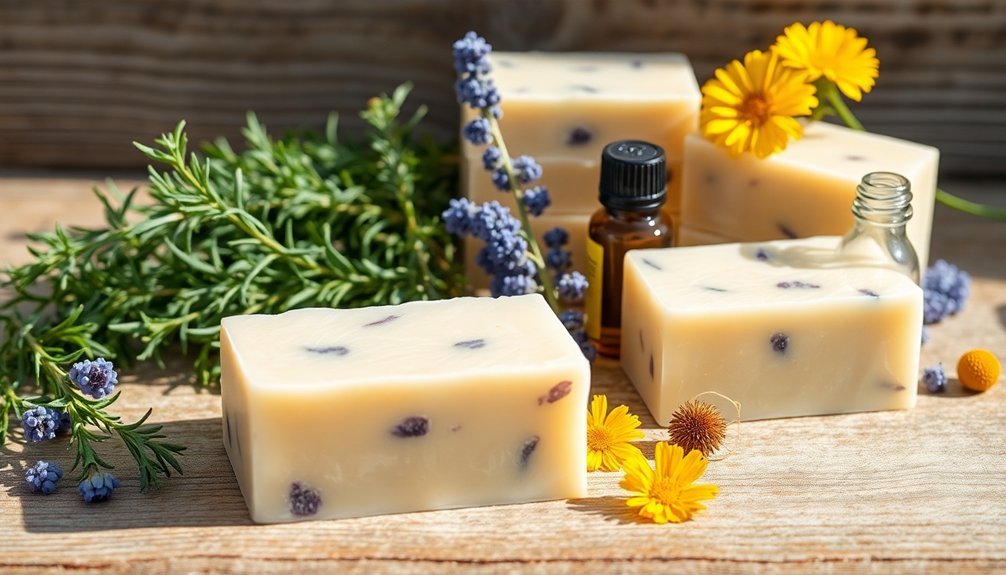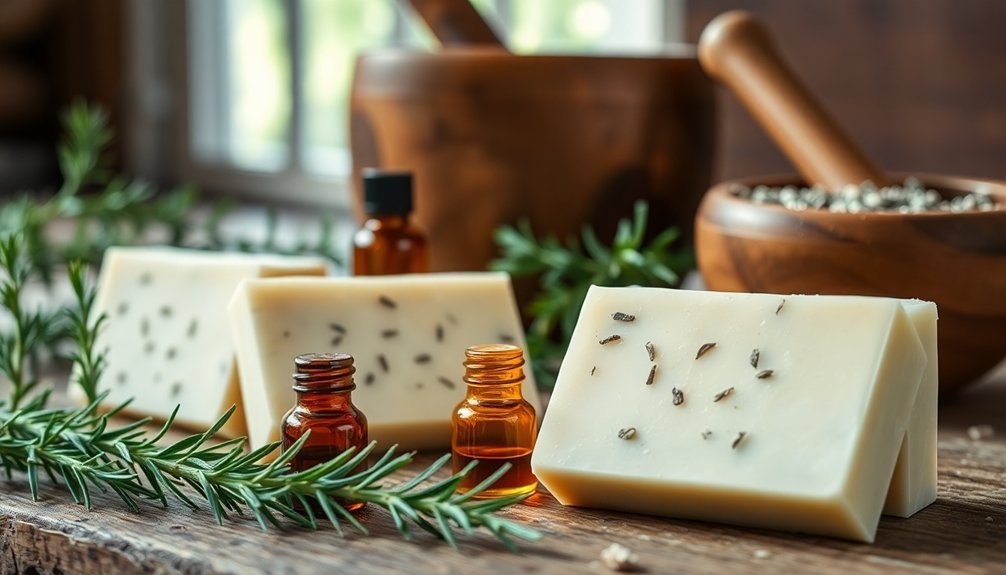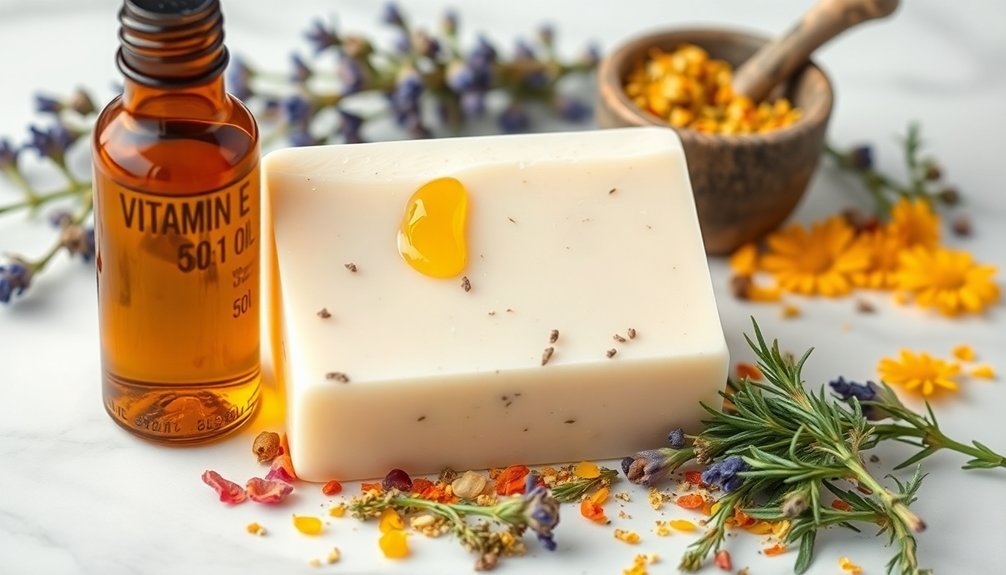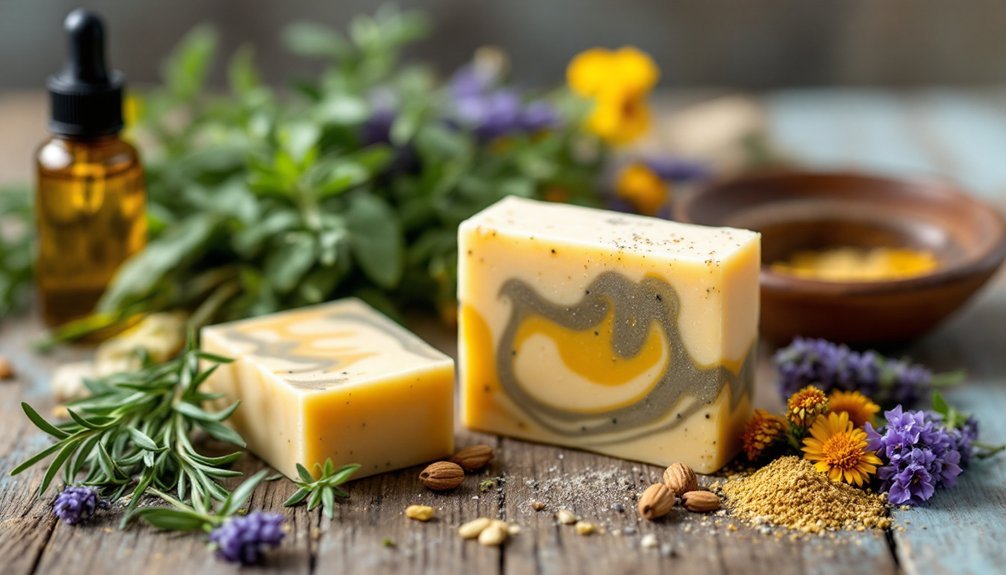Natural preservatives can extend your handmade soap's shelf life without compromising quality. Consider using rosemary extract (0.5-1%), grapefruit seed extract (0.5-2%), tea tree or lavender essential oils (1-3%), vitamin E (0.5-1%), and traditional botanicals like plantain and calendula. For water-based formulas, Leucidal Liquid SF (3-4%) paired with Geogard ECT (0.6-1%) works effectively. These plant-derived options protect against rancidity, mold, and bacteria while maintaining your soap's artisanal appeal. Discover how each preservative uniquely benefits your creations.
7 Plant Preservatives For Longer-Lasting Handmade Soap

While handmade soap typically has a naturally long shelf life due to its high pH, incorporating plant-derived preservatives can greatly extend its usability and freshness.
Products like Leucidal Liquid SF (3-4%) and Geogard ECT (0.6-1%) effectively prevent microbial growth in your homemade soap when used at recommended concentrations.
For oil-based soaps, consider Willow Bark Extract or Phytocide Elderberry OS, which protect your creations without synthetic chemicals.
Though not a true preservative, adding Vitamin E can slow oil rancidity, complementing your plant preservatives.
You'll maximize these benefits by storing your soaps in cool, dry places and using distilled water in your recipes to minimize contamination risks.
These simple practices, combined with quality plant preservatives, will greatly extend the shelf life of your artisanal creations.
Understanding Microbial Threats in Natural Soap Products
Although natural soap enjoys popularity for its gentle ingredients, it remains vulnerable to various microbial invaders that can compromise both safety and quality.
Bacteria, yeasts, and fungi can silently multiply in your handcrafted soaps, especially in water-based products like liquid formulations.
You'll need to pay particular attention to your soap's pH level. Traditional cold process soaps with higher pH naturally resist microbial growth, while neutral pH products require additional protection.
When you incorporate ingredients like milk, honey, or fresh plant extracts, you're inadvertently creating a more hospitable environment for microbes.
Without proper natural preservatives, these contaminants can cause skin irritations or infections when the soap touches your skin.
Water-based soaps are particularly susceptible, making preservation strategies essential for both safety and extending shelf life.
Rosemary Extract: The Antioxidant Powerhouse

Rosemary extract works as a powerful antioxidant in your handmade soaps by neutralizing free radicals that cause oils to deteriorate and become rancid.
You'll find this plant-based preservative most effective when added at 0.5-1% of your total oil weight, striking the perfect balance between preservation and formulation integrity.
The rosmarinic acid in the extract protects your soap's quality and extends shelf life without compromising your commitment to natural ingredients.
Antioxidant Properties Explained
Among the most powerful natural preservatives available to soap makers, rosemary extract stands out for its exceptional ability to combat oxidation in handmade soaps. Its high concentration of rosmarinic acid neutralizes free radicals that would otherwise damage your soap's oils, preventing that dreaded rancid smell.
When you add rosemary extract at 0.5-1% of your total oil weight, you'll extend the shelf life of your products considerably without affecting their scent profile.
| Property | Benefit | Application |
|---|---|---|
| Antioxidant properties | Prevents rancidity | Add at trace stage |
| Free radical neutralization | Maintains color stability | 0.5-1% of oil weight |
| Antimicrobial qualities | Reduces microbial growth | Works with all oil types |
Usage Rates Guide
Precision matters when incorporating rosemary extract into your soap formulations. For ideal results, add this natural preservative at 0.5% to 1% of your total oil weight. This small amount is sufficient to extend the shelf life of your handmade soaps by preventing oils from turning rancid.
When measuring rosemary extract, remember it functions best in environments with a pH between 4 and 7, making it versatile for various soap recipes. You'll not only gain antioxidant benefits but also enjoy its pleasant natural aroma and mild antimicrobial properties.
While rosemary extract works wonders for oil-based products, don't rely on it as the sole preservative for formulations containing water. For those products, you'll need additional preservation methods to guarantee complete protection.
Grapefruit Seed Extract: Broad-Spectrum Protection
Grapefruit Seed Extract offers some natural antioxidant properties that can help extend your soap's shelf life, though its antimicrobial effectiveness remains inconsistent.
For ideal results, you'll want to use GSE at concentrations between 0.5% and 2% in your formulations, being careful not to rely on it as your only preservative.
While GSE may contribute to mold prevention in your handmade soaps, you'll achieve better protection by combining it with other preservation methods rather than using it alone.
Natural Antioxidant Properties
When searching for natural preservation methods, you'll find Grapefruit Seed Extract (GSE) standing out as a powerful option for handmade soap protection.
What makes GSE particularly valuable is its rich antioxidant profile that helps combat rancidity in your soap formulations.
These natural antioxidants work by interrupting the oxidation process of oils and fats, effectively extending your product's shelf life and maintaining its original scent and appearance.
For ideal results, incorporate GSE at a concentration of 0.5% to 1% in your soap recipes.
While GSE offers significant protective benefits, be aware that its effectiveness varies based on source quality and extraction methods.
It's wise to view grapefruit seed extract as part of a preservation strategy rather than a complete solution, especially for products with high water content.
Effective Dosage Guidelines
Beyond its antioxidant benefits, proper dosage determines GSE's efficacy as a broad-spectrum protector in your handmade soaps. For ideal preservation, incorporate Grapefruit Seed Extract at 0.5% to 1% of your total soap weight—this recommended amount provides balanced protection without overwhelming your formulation.
Remember that GSE works best in environments with pH levels between 4 and 7, potentially limiting its effectiveness in high-alkaline soap bases.
While following effective dosage guidelines is essential, don't rely solely on GSE for preservation, especially in water-rich formulations.
To guarantee your preservation strategy succeeds, conduct stability testing with your specific recipe, as ingredient interactions can affect GSE's performance.
Consider pairing it with complementary preservatives for thorough protection that extends your soap's shelf life while maintaining its natural appeal.
Mold Prevention Benefits
Despite challenging conditions in homemade soap environments, GSE stands out as a powerful defender against mold proliferation. Your handcrafted soaps face constant exposure to moisture and organic materials—perfect breeding grounds for unwanted microbial growth.
Grapefruit seed extract's robust antimicrobial properties specifically target and inhibit common mold species that typically plague natural soap products. When incorporated at the recommended 0.5-1% concentration, GSE creates an inhospitable environment for mold spores while maintaining your soap's natural integrity.
For ideal mold prevention, verify you're using high-quality, unadulterated grapefruit seed extract from reputable suppliers. Remember that effectiveness varies with your soap's pH level and overall formulation.
While GSE isn't a guaranteed preservation solution for all recipes, it provides significant protection when properly integrated into well-formulated handmade soaps.
Tea Tree and Lavender Essential Oils as Preservative Agents
The dynamic duo of tea tree and lavender essential oils offers natural antimicrobial protection for your handmade soaps. When used at appropriate concentrations (1-3%), tea tree oil fights bacteria and fungi that could otherwise compromise your soap's shelf life.
While these essential oils enhance stability, they shouldn't replace traditional preservatives completely, especially in water-containing formulations:
- Tea tree oil contains powerful antimicrobial compounds that help prevent bacterial growth in your soap creations.
- Lavender essential oil adds both a soothing scent and natural antifungal properties to your handmade products.
- You'll need to carefully control oil concentrations to maximize preservation benefits while avoiding potential skin irritation.
Vitamin E: Preventing Rancidity in Soap Formulations

While many soapmakers mistakenly believe Vitamin E functions as a complete preservative, its true value lies in its antioxidant properties that specifically target oils and fats in your formulations.
For ideal protection against rancidity, add Vitamin E at 0.5-1% of your total oil weight. This is particularly important when working with unsaturated fats, which oxidize more quickly.
Remember that Vitamin E isn't a true preservative—it won't defend against bacteria or mold growth. Instead, it extends your soap's shelf life by slowing oxidation in oil-based ingredients.
For thorough protection, you'll need to pair Vitamin E with actual preservatives.
Consider Vitamin E as one component in your overall stability strategy rather than a standalone preservative solution. This approach guarantees your handmade soaps maintain both quality and safety.
Plantain and Calendula: Traditional Preserving Botanicals
For centuries, skilled soap artisans have turned to plantain and calendula as natural preserving agents in their formulations. These botanical powerhouses offer antimicrobial properties that help extend your soap's shelf life while adding skin-nourishing benefits.
When incorporating these natural preservatives into your handmade soaps, consider these methods:
- Create oil infusions with dried plantain leaves or calendula flowers to capture their antimicrobial compounds.
- Add botanical extracts at trace to maintain maximum preservative properties.
- Combine both plantain and calendula for complementary preservation effects that enhance product safety.
You'll find these ingredients not only help combat bacterial and fungal growth but also align with consumer preferences for natural formulations.
They work synergistically with other preservatives, offering a holistic approach that honors traditional soap-making wisdom while meeting modern safety standards.
Frequently Asked Questions
What Makes Homemade Soap Last Longer?
You'll extend your homemade soap's life by adding natural preservatives like Geogard ECT, maintaining higher pH levels, using distilled water, incorporating Vitamin E, and storing in cool, dry conditions away from humidity.
What Adds Longevity to Soap?
You'll extend your soap's life with natural preservatives like Geogard ECT, antioxidants such as vitamin E, and ingredients like salt. Maintaining proper pH levels and storing in cool, dry conditions prevents premature deterioration.
How Do You Store Homemade Soap Long Term?
Store your homemade soap in a cool, dry place away from sunlight. Wrap it in wax paper or use airtight containers. You'll preserve quality by keeping it well-ventilated. For maximum longevity, freezing's an excellent option.
How Do You Make Homemade Products Last Longer?
To make homemade products last longer, you'll need to add proper preservatives like Geogard ECT or Leucidal Liquid SF, store in cool dry places, use distilled water, make smaller batches, and add antioxidants like Vitamin E.
In Summary
When you craft your handmade soaps, you're not limited to synthetic preservatives. These seven plant-based options offer effective protection against microbial growth while maintaining your soap's natural integrity. Whether you're using antioxidant-rich rosemary extract or the antimicrobial power of tea tree oil, you'll extend your soap's shelf life while keeping your creations genuinely natural. Experiment with these botanical preservatives to discover what works best for your unique formulations.





Leave a Reply